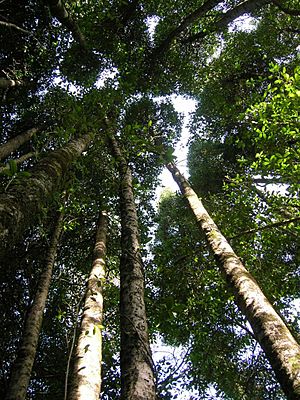Maulino forest facts for kids
The Maulino forest (Spanish: Bosque Maulino) is a special type of forest. It grows naturally in the Chilean Coast Range in Central Chile. You can find it between 35°55 and 36°20 South latitude.
This forest is unique because it grows where two different climates meet. It's found where the dry Mediterranean climate meets a more humid, wet climate. The forest gets about 700 to 1000 millimeters of rain each year. Most of this rain falls during the winter months. Experts like Humberto Fuenzalida and Edmundo Pisano say it's a forest that likes a moderate amount of water. It's like a mix between a dry forest and a rainforest.
Contents
Plants of the Maulino Forest
The main tree you'll see in the Maulino forest is called Nothofagus glauca. It's a very important tree here.
Other trees that grow in this forest include:
- Nothofagus × leoni
- Nothofagus alessandrii
- Gomortega keule
Scientists José San Martín and Claudio Donoso have identified three main types of Maulino forest, based on the trees that grow there:
- Forests where Nothofagus glauca is the main tree.
- Forests with many Nothofagus antarctica trees.
- Forests where Nothofagus alessandrii is common.
One cool thing about the Maulino forest is its high level of endemism. This means many of the plants and animals found here don't live anywhere else in the world!
Animals of the Maulino Forest
The Maulino forest is home to many interesting animals, especially birds. Some of the native birds you might spot include:
- The Magellanic tapaculo (Scytalopus magellanicus)
- The ochre-flanked tapaculo (Eugralla paradoxa)
- The Chestnut-throated huet-huet (Pteroptochos castaneus)
You might also be lucky enough to see the southern pudu (Pudu puda). This is a very small deer. It has been seen in the forest, including near Tregualemu in the Pelluhue area.
Challenges for the Forest
Over time, large parts of the Maulino forest have been cut down. This was done to make space for farming. Cutting down the trees caused a lot of soil to wash away. After this, many areas were planted with non-native trees like Eucalyptus globulus and Pinus radiata.
These new tree plantations have caused the forest to break into smaller pieces. This is called fragmentation. Luckily, this breaking up hasn't seemed to harm some native animals much. For example, some tapaculo birds and beetles that live on the ground (called epigeic beetles) seem to be okay. Some experts think that if the new plantations have enough smaller plants growing underneath them, fragmentation might not be a big problem. However, the number of different small mammals has gone down because of this fragmentation.
Interestingly, smaller pieces of Maulino forest sometimes have more different types of trees than larger, protected areas. Even though these smaller forest pieces might have some plants that aren't native, they are still very important for protecting the native plants and animals. Researchers Pablo I. Becerra and Javier A. Simonetti believe that breaking the forest into pieces is less harmful than completely replacing it with other types of trees.
Protected Areas
People are working to protect the Maulino forest. Here are two important protected areas:
Los Queules National Reserve
This reserve protects 145 hectares (about 360 acres) of native forest. This is part of a larger 600-hectare forest area. The main tree you'll find here is the hualo (Nothofagus glauca). Other native trees include the queule (Gomortega keule). The reserve is actually named after the queule tree!
Los Ruiles National Reserve
This reserve protects about 45 hectares (about 111 acres) of Maulino forest. It's home to the ruil tree (Nothofagus alessandrii). Just like Los Queules, this reserve is named after one of its special trees – the ruil.
See also
 In Spanish: Bosque maulino para niños
In Spanish: Bosque maulino para niños


